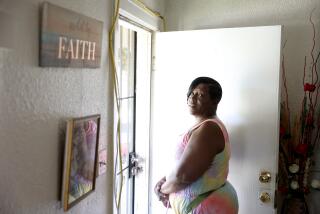Most Absent Parents Fail to Pay Support, Study Finds : Families: State is ranked among the worst in seeing that eligible children receive payments owed them.
Half of Californiaâs 7.8 million children will live in single-parent households before they reach their 18th birthdays, and most of them will suffer a dramatic decline in their standard of living because the majority of absent parents are failing to pay child support, according to a study to be released today.
Virtually all children living with a single parent are entitled to child support but fewer than half--and in some parts of California only about 20%--receive the money due to them, the study found.
Absent parents--usually fathers--enjoy a 41% rise in income after divorce. But children and their mothers typically experience a 31% drop in their income--enough to change their standard of living and in many cases push them below the poverty line.
This in turn costs taxpayers, the study said, because tax dollars support the Aid to Families With Dependent Children program.
The study, published by Children Now, a California-based advocacy organization, is said to be the first to examine how the performance of Californiaâs child support system affects children. Experts say it is the most comprehensive report of its kind in the nation.
âChild support is a real sleeper as a childrenâs issue,â said Wendy Lazarus, vice president of Children Now. âMost think of it as a bureaucratic system that wonât affect them. . . . In fact, it touches more children than any other state program, except for the public schools.â
Children in California have had a legal right to child support since 1872. Whether they were ever married, mothers and fathers have had legal obligations for the financial support of their children. But most parents do not do so voluntarily, and most states do little to force them to meet their obligations, the study found.
By many accounts, California has one of the least effective child support systems in the country, the report said. A 1991 study by the House Ways and Means Committee gave the state an overall grade of D and ranked it 47th in the country in several key indicators of how effectively its child support program was run.
Even though California has one of the highest per capita incomes in the country, it ranked 49th in the average size of child support payments, according to a Rockefeller Foundation survey. In 1989-90, the average California award was $4,936, or $411 per month, compared to a national average of $6,040, or $503 a month.
In 1990 alone, 1.6 million California children--one out of every five--lived with just one parent, according to the Children Now study. Of those, 43% were Anglo, 31% Latino, 17% black, 6% Asian-American and 3% other ethnic backgrounds.
It is unknown how many of these children are not being supported by absent parents. But the state reports at least $2.5 billion in uncollected child support payments, Children Now found by surveying district attorneysâ offices.
Some parents go through district attorneysâ offices to try to collect child support. In 1990, the study concluded, only 39% of child support orders tracked by district attorneys in California resulted in any payment.
Whether youngsters get child support payments from absent parents depends greatly on where they happen to live, the researchers found. A child who lived in San Luis Obispo County had more than a 64% chance of getting at least some portion of the support ordered between 1987 and 1990, but a child in El Dorado County had only a 21% chance of getting some full or partial payments during that period.
In Orange County, 53.2% of the child support orders were at least partially paid. In Riverside County, the figure was 40.1%; in San Bernardino County, 48.8%; in San Diego County, 41.7%; in Santa Barbara County, 58.7%; in Ventura County, 44.4%.
In Los Angeles County--home to nearly one-third of Californiaâs children--only 37% of the support ordered in 1987 was paid. By 1990, the figure had dropped to 34%. And Los Angeles County was not alone in seeing a drop in child support payments. Eleven of the stateâs 15 most populous counties experienced declines. Although the reasons are not entirely clear, the legislative analystâs office concluded in a report issued in January that a âsignificant factorâ in how well a county performed was the amount of money invested relative to the countyâs child support caseload.
For Los Angeles County, one of the difficult problems is finding missing parents, said Barbara Catlow, assistant director of the Bureau of Family Support. The county now has 350,000 child support cases. Of those, 130,000 have âordersâ attached to them, meaning that the district attorney or the court has established a payment schedule based on the parentsâ incomes. But in 75,000 of the cases, the district attorneyâs office does not have current addresses for the absent parents.
Parents who try to collect payments for their children tell stories of a dozen or more trips to court and endless delays in getting payment. District attorney staffers tell of mountains of paperwork and a workload that averages 1,400 cases per person.
The minimum time for getting child support payments through a district attorneyâs office is six months, the study found, and the process usually takes much longer, if it is ever completed.
Officials say the situation should improve dramatically within a year in Los Angeles County when the district attorneyâs Bureau of Family Support improves its automation. This will allow caseworkers to trace the names and addresses of absent parents through utility companies, the Department of Motor Vehicles and tax enforcement agencies.
Child experts would like to see major changes in child support systems throughout the country.
âWhen it comes to the inadequacy of its child support system, California is in good company, Iâm afraid,â said Paula Roberts of the Center for Law and Social Policy in Washington, one of the nationâs leading experts on child support. âThe child support system in this country simply does not function properly.â
One of the most important reforms, many experts believe, would be to establish paternity at birth and simplify the mechanisms for establishing paternity for older children. Seventeen states have already taken such steps, and a similar bill, SB 1959, introduced by Sen. Gary K. Hart (D-Santa Barabara) and sponsored by Children Now, is pending in the Legislature.
Since 1970, the report found, there has been a 273% increase in the number of babies born to unmarried mothers. That increase accounts for much of the growth in uncollected child support and much of the poverty facing children today.
The report found that while 84% of unmarried teen-age mothers are in contact with the fathers at that time of childbirth, only 55% remain in contact by the time the child is 3 years old, thus making it highly unlikely that absent fathers are providing financial support.
Many states, including Washington and Virginia, now have state-administered child support systems that require employers to garnish wages of absent parents and pay them to the child support agency for disbursement. Assemblywoman Jackie Speier (D-San Francisco) has introduced legislation, AB 3589, sponsored by the Childrenâs Advocacy Institute, a Sacramento lobbying group, that would allow the Franchise Tax Board to collect overdue child support payments.
This spring, Congress is expected to consider legislation that would allow the federal government to take over child support collection, automatically deducting it from pay in much the same way that taxes and Social Security payments are deducted.
Collecting Child Support
A major study by Children Now, a nonpartisian California advocacy organization, found California among the worst states in the nation in collecting child support payments. The following list of 15 counties shows the average percentage of cases in which some child support was collected through district attorneyâs offices between 1987 and 1990. Contra Costa: 42.4% Fresno: 35.0% Los Angeles: 35.7% Marin: 54.5% Monterey: 42.6% Orange: 53.2% Riverside: 40.1% Sacramento: 44.7% San Bernardino: 48.8% San Diego: 41.7% San Francisco: 43.3% San Mateo: 51.8% Santa Barbara: 58.7% Santa Clara: 27.7% Ventura: 44.4% Source: Children Now, Los Angeles
BACKGROUND
The 33-page study, âFor the Sake of the Children,â was based on a year of research and interviews with child experts and parties involved at all levels of the child support system. Prepared by Children Now, a California research and advocacy organization, the report also relied on numerous recent studies by other organizations, including the U.S. Bureau of Census, the California Legislative Analysts Office, the California Department of Finance and the U.S. House of Representatives Committee on Ways and Means.
More to Read
Sign up for Essential California
The most important California stories and recommendations in your inbox every morning.
You may occasionally receive promotional content from the Los Angeles Times.






![[20060326 (LA/A20) -- STATING THE CASE: Marchers organized by unions, religious organizations and immigrants rights groups carry signs and chant in downtown L.A. "People are really upset that all the work they do, everything that they give to this nation, is ignored," said Angelica Salas of the Coalition of Humane Immigrant Rights. -- PHOTOGRAPHER: Photographs by Gina Ferazzi The Los Angeles Times] *** [Ferazzi, Gina -- - 109170.ME.0325.rights.12.GMF- Gina Ferazzi/Los Angeles Times - Thousands of protesters march to city hall in downtown Los Angeles Saturday, March 25, 2006. They are protesting against House-passed HR 4437, an anti-immigration bill that opponents say will criminalize millions of immigrant families and anyone who comes into contact with them.]](https://ca-times.brightspotcdn.com/dims4/default/34f403d/2147483647/strip/true/crop/1983x1322+109+0/resize/840x560!/quality/75/?url=https%3A%2F%2Fcalifornia-times-brightspot.s3.amazonaws.com%2Fzbk%2Fdamlat_images%2FLA%2FLA_PHOTO_ARCHIVE%2FSDOCS%2854%29%2Fkx3lslnc.JPG)



